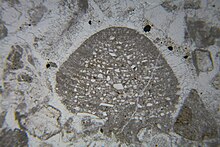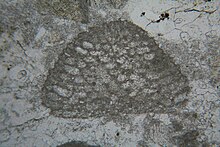Orbitolines
| Orbitolines | ||||||
|---|---|---|---|---|---|---|

Orbitolines in Cretan limestone; Portugal |
||||||
| Temporal occurrence | ||||||
| Barremium to Maastrichtium | ||||||
| 130 to 65.5 million years | ||||||
| Systematics | ||||||
|
||||||
| Scientific name | ||||||
| Orbitolina | ||||||
| d'Orbigny 1850 | ||||||
In paleontology, orbitolines are a group of large fossil foraminifera belonging to the genus Orbitolina . They occur in certain Cretaceous sediments (for example in the orbitoline layers named after them ) as important rock formers .
Systematics
The position of the genus within the system of foraminifera is unclear. The Orbitolinidae family , established as early as 1890, was seen early as a heterogeneous unit that is morphologically defined and includes various convergent lines. Later the genus was then classified in the superfamily Orbitolinacea (suborder Textulariina ). Within the genus Orbitolina , different species have been described on the basis of morphological criteria, but it was also believed that these morphological differences in the housing are largely due to environmental influences, and that the genus in reality only includes one species, which was called Orbitolina lenticularis . Other authors, however, delimit the forms of the Lower Cretaceous in a separate genus Palorbitolina .
distribution
The genus Orbitolina is restricted to the Cretaceous period , although the details of the exact period vary from Barremium to Maastrichtian to Albium to Cenomanium . Geographically, they can be found in the area of the former Tethys Ocean .
morphology
The housings of the orbitolines are cone-shaped and have a diameter of a few millimeters to three centimeters, according to other information also up to six centimeters. The opening angle of this cone can vary over a wide range, so that in extreme cases an almost disk-shaped habit is achieved. The embryonic chamber sits at the tip of the cone. On the inside of the cone mantle, the so-called epidermis, there are the other chambers, which are subdivided by intricately arranged partition walls (septa). The walls are agglutinated from fine grains of sand and contain calcareous cement. The chambers form just a simple layer in a ring-shaped arrangement on the inside of the epidermis; further inward there is a zone divided by radial septa, which finally merge into an irregular network inside. Since this inner part of the cone is filled with agglutinated grains of sand, the structure here is difficult to see.
If only thin sections through solid rock containing orbitolines are available for the investigation , which do not allow a specific orientation of the cutting plane to the individual housings, the insight into the structure depends on chance. Systematic investigations require oriented sections through individual housings.
As with many foraminifera, a generation change takes place, which is reflected in a dimorphism of the shell: Those with microspherical (small) and megalospheric (large) embryonic chambers. The microspherical housings are usually larger, less conical in shape and fewer in number than the megalospheric ones. At some sites, the megalospheric housings can still be divided into two types, so that there is even a trimorphism.
Locations
In Germany, orbitoline-bearing rocks can be found in the Alps, for example, in the Schrattenkalk Formation of the Helveticum , which extends from the Allgäu to Upper Bavaria, and in the Cenomanian layers of the Eastern Alps . Since these rocks were transported as glacier debris or river rubble far into the Alpine foothills , these fossils can also be found there.
In Switzerland, the Schrattenkalk formation on the northern edge of the Alps is much more extensive than in Germany; Finds in this area are correspondingly more frequent. There are extensive occurrences of orbitoline-bearing rocks in Europe in France and Spain, as well as sites in Portugal, Italy, Hungary and England. Outside of Europe, these fossils are found in Tunisia, Algeria, Israel, Lebanon, Syria, the Arabian Peninsula, Iran, Burma, the island of Borneo, the United States of America, Mexico and Venezuela.
literature
- Arno Hermann Müller (ed.): Textbook of palaeozoology. Volume II, part 1, 4th edition, Gustav Fischer Verlag 1993, pp. 62-63.
- Vladimir Pokorny: Basics of Zoological Micropalaeontology. Volume I, VEB Deutscher Verlag der Wissenschaften, Berlin 1958 (Reprint 1975), pp. 201–216.
- Wilfried Rönnfeld: Foraminifera. A catalog of typical shapes. 2nd edition, self-published, Tübingen 1999.
- Jan Hofker: Studies on the Genus Orbitolina (Foraminiferida). Van JJ Groen & ZN. NV, Leiden 1963.
Individual evidence
- ↑ Vladimir Pokorny: Basics of Zoological Micropalaeontology. P. 213
- ^ Hofker: Studies on the Genus Orbitolina (Foraminiferida) . 1963, p. 216-219 .
- ^ A b Rolf Schroeder: Microfossils from the Schrattenkalk (Upper Barrême) west of the Tegernsee and the Lower Cenomaniac southwest of Ruhpolding (Upper Bavaria) . In: Bayerisches Geologisches Landesamt (Ed.): Geologica Bavarica . tape 82 . Munich 1981, p. 389-398 .
- ↑ Arno Hermann Müller (ed.): Textbook of palaeozoology. P. 62.
- ^ Wilfried Rönnfeld: Foraminifera. A catalog of typical shapes. P. 6.
- ↑ a b Rolf Schroeder: Orbitolines of the cenomans of southwest Europe. In: Paleontological Journal. Volume 36, 1962, pp. 171-173.
- ↑ Bavarian Geological State Office (ed.): Geological map of Bavaria 1: 25000, explanations for sheet no. 8241 Ruhpolding . Munich 1970, p. 86 .
- ^ Jan Hofker: Studies on the Genus Orbitolina (Foraminiferida) . 1963, p. 223 .
- ^ Jan Hofker: Studies on the Genus Orbitolina (Foraminiferida) . 1963, p. 202 .
- ^ Jan Hofker: Studies on the Genus Orbitolina (Foraminiferida) . 1963, p. 187-198 .

